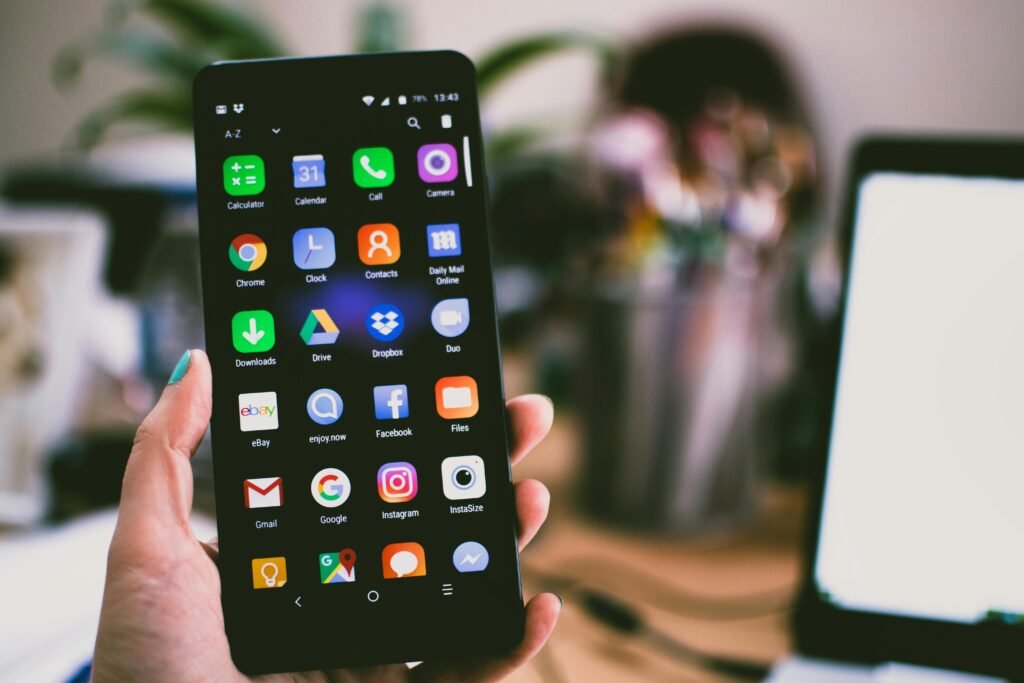
Introduction to Smart Smartphone Technology
The evolution of smartphone technology has undergone a remarkable transformation since the inception of mobile devices. Initially, mobile phones were primarily designed for voice communication, lacking the features that define today’s smartphones. With the advent of smart smartphone technology, mobile devices have not only become essential tools for communication but also versatile platforms for a wide array of functions that enhance daily living.
Smartphones are characterized by their ability to connect to the internet, allowing users to access a plethora of information and services with unparalleled ease. This connectivity paved the way for the development of various applications, commonly known as apps, that serve distinct purposes ranging from communication to productivity and entertainment. Consequently, the smartphone has become a central hub for managing personal and professional tasks. Applications like social media platforms, navigation tools, and productivity software have revolutionized the way individuals interact and organize their lives.
Another key aspect of smart smartphone technology lies in its advanced computing capabilities. Unlike traditional mobile phones, modern smartphones are equipped with powerful processors and ample memory, enabling them to perform complex tasks that previously required dedicated computing devices. This capability allows for multitasking and access to high-performance applications, further blurring the lines between mobile phones and personal computers. Furthermore, the integration of technologies such as artificial intelligence and machine learning enhances the functionality of smartphones, providing personalized experiences and predictive capabilities that adapt to user behaviors.
In summary, the trajectory of smartphone technology reflects a continuous push toward greater versatility and connectivity, underpinned by advanced hardware and innovative software solutions. As we delve deeper into the specifics of smart smartphone technology, it becomes evident that these devices are indispensable tools in the modern digital landscape.
Key Features of Modern Smartphones
In today’s rapidly evolving technological landscape, smartphones have emerged as indispensable tools that enhance our daily lives. A standout feature of modern smartphones is their high-resolution displays. With advancements in screen technology, users can now enjoy vibrant colors and sharp images, making everything from browsing to media consumption more visually appealing. AMOLED and Retina displays, for instance, provide deeper blacks and greater contrast ratios, significantly elevating the overall viewing experience.
Another critical aspect to consider is the powerful processors embedded within these devices. Manufacturers such as Apple, Samsung, and Qualcomm have developed cutting-edge chipsets that deliver exceptional performance, enabling smooth multitasking and efficient app usage. The latest smartphone processors utilize advanced architectures that not only increase speed but also optimize energy consumption, prolonging battery life without compromising functionality.
Moreover, the capabilities of advanced camera systems have revolutionized mobile photography. Modern smartphones are equipped with multiple lenses, including wide-angle, telephoto, and macro, empowering users to capture stunning images in various situations. Features such as optical zoom, night mode, and enhanced image stabilization facilitate remarkable photo quality, making smartphones a popular choice among amateur and professional photographers alike.
Beyond hardware improvements, software capabilities have drastically transformed user interaction with smartphones. The integration of artificial intelligence (AI) and machine learning has ushered in new possibilities for personalization and automation. AI-driven features, like voice recognition, predictive text, and smart assistants, enhance user experiences by making devices more intuitive and responsive to individual needs.
Through the synthesis of high-resolution displays, powerful processors, advanced camera technologies, and AI enhancements, modern smartphones stand at the forefront of mobile innovation, catering to increasingly sophisticated user demands and expectations.
The Role of Operating Systems in Smartphones
Operating systems (OS) serve as the backbone of smartphones, providing the necessary platform for software to interact with hardware components and enabling users to leverage mobile innovation effectively. The two dominant players in the smartphone market—Android and iOS—have set the standards in terms of user experience, security, and app ecosystems. Understanding how these operating systems function is crucial to appreciating their impact on smartphone technology.
Android, developed by Google, is an open-source operating system that is widely customizable. This flexibility allows manufacturers to tailor their devices according to specific user needs, supporting a broad range of applications and hardware configurations. Android’s vibrant app ecosystem is one of its significant strengths, as it enables developers to create a plethora of applications. This, in turn, fosters innovation, allowing users to enhance their smartphones’ functionality with a wide variety of tools and services tailored to diverse interests.
On the other hand, Apple’s iOS is a closed operating system known for its user-friendly interface and robust security features. Unlike Android, iOS provides a standardized experience across its devices, ensuring a level of consistency that many users appreciate. Although it is less adaptable than its Android counterpart, iOS offers a well-curated app ecosystem where quality is often prioritized over quantity. This emphasis on quality contributes to a seamless experience for users, as applications tend to function more reliably within the iOS framework.
Both Android and iOS continue to evolve, integrating emerging technologies such as artificial intelligence and augmented reality into their core functionalities. These operating systems play a pivotal role in driving smartphone innovation forward, as they not only enhance user experience but also empower developers to push the boundaries of what smartphones can achieve.
Smartphone Connectivity: The Backbone of Smart Technology
Smartphone connectivity represents a critical facet of smart technology, as it enables various features and functionalities that enhance user engagement and overall experience. Among the plethora of connectivity options available today, Wi-Fi, Bluetooth, Near Field Communication (NFC), and cellular networks like 5G stand out as the most significant. Each of these technologies plays an essential role in shaping how users interact with their devices and access content.
Wi-Fi is perhaps the most ubiquitous connection type, allowing smartphones to access the internet without the constraints of mobile data. With the advent of Wi-Fi 6, users can expect faster speeds and improved performance in congested environments. This development positively impacts functionalities such as video streaming, gaming, and cloud storage access, making them more seamless and efficient for users.
Bluetooth connectivity enables smartphones to communicate with a variety of peripheral devices such as headphones, smartwatches, and even home automation systems. The latest iterations, like Bluetooth 5.0, offer improved range and speed, supporting innovative applications such as remote health monitoring and smart home integration. The growing trend of smart homes relies heavily on the interconnectedness provided by Bluetooth technology.
Furthermore, NFC allows for quick and secure transactions, exemplified in mobile payment systems like Apple Pay and Google Wallet. This technology facilitates a frictionless shopping experience, transforming smartphones into digital wallets and promoting cashless interactions. The ease and security of NFC technology drive user adoption in retail environments.
Lastly, cellular networks are rapidly evolving, with 5G becoming a pivotal enabler of smart technology. Offering unprecedented data speeds and reduced latency, 5G connectivity empowers smartphones to deliver richer experiences in augmented reality, virtual reality, and cloud-based gaming. As these networks become more prevalent, users can expect to engage with their devices and applications on entirely new levels.
In summary, the various connectivity options available in smartphones form the backbone of smart technology. With continuous advancements in mobile connectivity, the ways users interact with their devices are set to become even more profound in the future.
Smartphone Security and Privacy Considerations
The integration of advanced technology in smartphones has revolutionized communication and access to information; however, it has also introduced significant security and privacy risks. By understanding these considerations, users can better safeguard their data against emerging threats. One of the primary methods of enhancing smartphone security is through biometric authentication, which includes fingerprint scanners and facial recognition systems. These innovative features provide an extra layer of protection, ensuring that only authorized users can access their device.
Encryption plays a crucial role in protecting sensitive information stored on smartphones. It converts data into a coded format, making it unreadable without the proper key. This is particularly important as data breaches continue to rise, with cybercriminals increasingly targeting personal information for malicious purposes. Smartphone manufacturers are continuously working to improve encryption standards, employing advanced algorithms to ensure user data remains secure.
Another essential aspect of smartphone security involves app permissions. As users download applications, they frequently overlook the permissions these apps request, granting access to personal information such as location, contacts, and camera. It is vital for users to exercise caution when installing new applications and to regularly review app permissions. Developers are now being encouraged to implement more transparent practices regarding data collection, which is crucial for enhancing user trust and safeguarding privacy.
Recent trends in cybersecurity threats, including malware and phishing attacks, have prompted smartphone manufacturers to adopt proactive measures. Regular software updates not only improve functionality but also patch any vulnerabilities that could be exploited by hackers. With users increasingly dependent on smartphones for everyday tasks, understanding these security measures is essential for protecting personal information and maintaining privacy in an ever-evolving digital landscape.
The Impact of Smart Technology on Daily Life
The advent of smart smartphone technology has significantly transformed various facets of daily life, reshaping routines, enhancing communication, and altering social interactions. As individuals integrate these powerful devices into their lives, the impact becomes apparent in virtually every aspect of personal and professional existence. Smartphones have evolved into indispensable tools, acting as facilitators of convenience in myriad ways.
One of the most striking changes brought about by smartphones is the way we communicate. Traditional forms of communication have largely been supplanted by instant messaging and video calling applications, which allow users to connect with others in real time, irrespective of geographical barriers. This instant connectivity fosters deeper relationships while also encouraging new social norms. Moreover, the rise of social media platforms has redefined how individuals engage with their communities and share their experiences, thus influencing public discourse and interpersonal relationships.
Furthermore, smartphones have a profound impact on productivity and entertainment. A plethora of applications can enhance time management by enabling users to organize tasks efficiently, set reminders, and track deadlines. These functionalities empower individuals to optimize their daily schedules, ultimately increasing overall productivity. In terms of entertainment, smartphones provide an extensive array of options, from streaming services to mobile games, effectively putting an entire world of content at users’ fingertips. Consequently, entertainment consumption has become more personalized, allowing users to choose what, when, and how they engage with media.
The way information is consumed has also undergone a transformation due to the rise of smartphones. News, educational resources, and information-sharing platforms are now available at the touch of a button, enabling users to stay informed and enhance their knowledge base. By placing vast repositories of information within reach, smartphones empower users to engage with the world around them more effectively. Thus, smart technology has not only revolutionized communication but has also fundamentally changed how individuals interact with information, productivity, and entertainment on a daily basis.
Future Trends in Smartphone Technology
The landscape of smartphone technology is continually evolving, driven by consumer demands and technological advancements. One of the most notable emerging trends is the development of foldable devices. These smartphones combine the functionality of larger-screen tablets with the portability of traditional smartphones. As manufacturers innovate in hinge mechanics and display durability, foldable smartphones are expected to become increasingly mainstream. With the ability to multitask more efficiently and utilize larger displays without compromising portability, foldable devices could redefine user interaction and productivity.
Another promising trend is the integration of augmented reality (AR) into smartphones. As AR technology matures, manufacturers are exploring ways to incorporate immersive experiences directly into everyday devices. Enhanced camera capabilities and improved processing power will enable consumers to interact with their environments in innovative ways, from gaming and education to practical applications in retail and design. This trend not only enhances user experience but also opens up new markets for developers creating AR applications tailored to mobile devices.
Advancements in battery life are also a pivotal focus area for smartphone manufacturers. As user demands for powerful, efficient devices grow, innovations in battery technology, such as solid-state batteries and renewable energy sources, are being prioritized. Not only do consumers expect longer battery life, but they are also becoming increasingly concerned with sustainability. Future smartphones may leverage eco-friendly materials and energy-efficient designs, effectively addressing both power consumption and environmental impact. The trend toward sustainable technology aligns with broader consumer expectations for responsible product development.
In conclusion, as we look towards the future of smartphone technology, trends such as foldable devices, augmented reality, and sustainable battery solutions will play a significant role in shaping consumer experiences and expectations. This ongoing evolution represents an exciting chapter in mobile innovation, with the potential to transform how we interact with technology on a daily basis.
Challenges Facing Smartphone Manufacturers
The smartphone industry has witnessed unprecedented growth over the past decade, yet it now faces several formidable challenges that threaten the sustainability of its development. One of the most significant issues is market saturation. As a result of rapid technological advancements and increasing accessibility, most consumers now own smartphones, which diminishes the potential for substantial growth in developed markets. Manufacturers are compelled to innovate continuously to capture the diminishing pool of new users while retaining existing customers.
Another critical challenge confronting smartphone manufacturers is the environmental impact of e-waste. With millions of devices reaching the end of their lifecycle annually, the amount of electronic waste generated is alarming. This raises concerns regarding sustainability and corporate responsibility, as smartphones contain hazardous materials that can harm the environment if not disposed of properly. In response, various companies are adopting eco-friendly designs and promoting recycling initiatives, aiming to lessen their carbon footprint and contribute positively to the environment.
Moreover, intense competition among smartphone manufacturers further complicates the landscape. With numerous brands vying for market share, companies must differentiate their products through innovative features, design, and pricing strategies. This competitive pressure forces manufacturers to realize efficiencies in production while maintaining high-quality standards, which can be a challenging balancing act.
In this rapidly changing environment, companies are adapting their strategies by embracing emerging technologies, such as artificial intelligence and 5G connectivity, to offer unique value propositions. By aligning their business models with current market demands, smartphone manufacturers can navigate the intricate challenges and continue to thrive in an increasingly competitive field.
Conclusion: Embracing the Future of Smartphones
As we have explored, the landscape of smartphone technology is marked by rapid advancements and transformative innovations. From the integration of artificial intelligence to the evolution of camera capabilities and connectivity, each development signals the potential to radically alter our interaction with mobile devices. Smartphones are no longer limited to basic communication; they have become multifunctional tools that influence various aspects of our daily lives, including work, education, and leisure.
The continuous evolution of this technology necessitates that users remain informed and adaptable. The launch of 5G networks, for instance, has set the stage for high-speed internet connectivity that enhances mobile experiences, enabling functionalities like streaming high-definition content, improved remote working capabilities, and more seamless gaming experiences. Such innovations are indications of how smartphones are not merely devices for communication but pivotal platforms that foster innovation across numerous sectors.
Moreover, the increasing emphasis on user privacy and security features reflects a growing awareness among manufacturers and consumers alike about the importance of safeguarding personal information. As more personal data is stored within smartphones, the demand for robust security measures is paramount. This factor is critical for anyone looking to invest in a new smartphone, making it necessary to consider brands that prioritize data protection.
Looking ahead, it is clear that the smartphone industry will continue to witness remarkable advancements. As technology progresses, the capabilities of these devices will expand further, offering even more convenience and efficiency. Therefore, users should embrace these changes, staying informed about new features and advancements that can enhance their experiences. The future of smartphones promises exciting opportunities, urging everyone to remain open to innovation and adaptable to the changes it brings.




